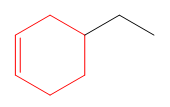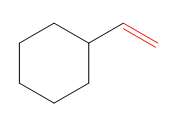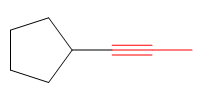
Concept explainers
(a)
Interpretation:
The root for the given molecule is to be determined.
Concept introduction:
In case of molecules containing a
Answer to Problem B.1P
The root for the given molecule is cyclohexene.
Explanation of Solution
The given molecule is

In this molecule, the largest ring containing the double bond has six carbon atoms. Hence, the root is cyclohexene, as shown below.

The root is determined from the longest carbon chain or the largest ring containing the double or triple bond between the carbon atoms.
(b)
Interpretation:
The root for the given molecule is to be determined.
Concept introduction:
In case of molecules containing a
Answer to Problem B.1P
The root for the given molecule is ethene.
Explanation of Solution
The given molecule is

In this molecule, the double bond is a part of the chain attached to the ring. Although the ring has more carbon atoms than the side chain, the ring does not contain a

The root is determined from the longest carbon chain or the largest ring containing the double or triple bond between the carbon atoms.
(c)
Interpretation:
The root for the given molecule is to be determined.
Concept introduction:
In case of molecules containing a
Answer to Problem B.1P
The root for the given molecule is propyne.
Explanation of Solution
The given molecule is

In this molecule, the triple bond is a part of the chain attached to the ring. Although the ring has more carbon atoms than the side chain, the ring does not contain a

The root is determined from the longest carbon chain or the largest ring containing the double or triple bond between the carbon atoms.
(d)
Interpretation:
The root for the given molecule is to be determined.
Concept introduction:
In case of molecules containing a
Answer to Problem B.1P
The root for the given molecule is hexene.
Explanation of Solution
The given molecule is

In this molecule, the longest carbon chain containing the double bond has six carbon atoms. Hence, the root is hexene, as shown below.

The root is determined from the longest carbon chain or the largest ring containing the double or triple bond between the carbon atoms.
Want to see more full solutions like this?
Chapter B Solutions
Organic Chemistry: Principles and Mechanisms (Second Edition)
 Organic Chemistry: A Guided InquiryChemistryISBN:9780618974122Author:Andrei StraumanisPublisher:Cengage Learning
Organic Chemistry: A Guided InquiryChemistryISBN:9780618974122Author:Andrei StraumanisPublisher:Cengage Learning
